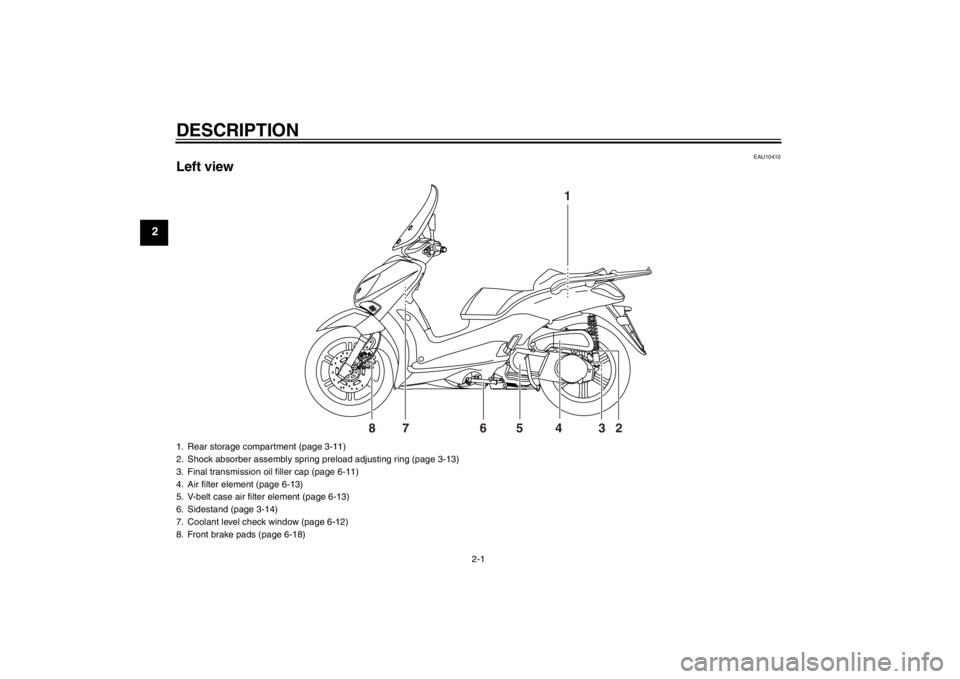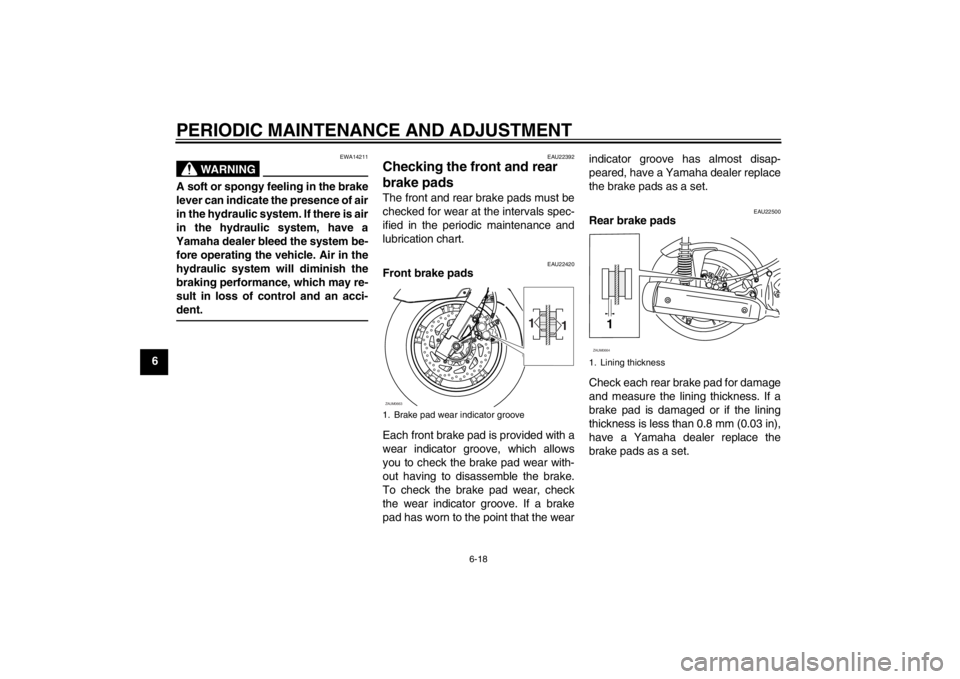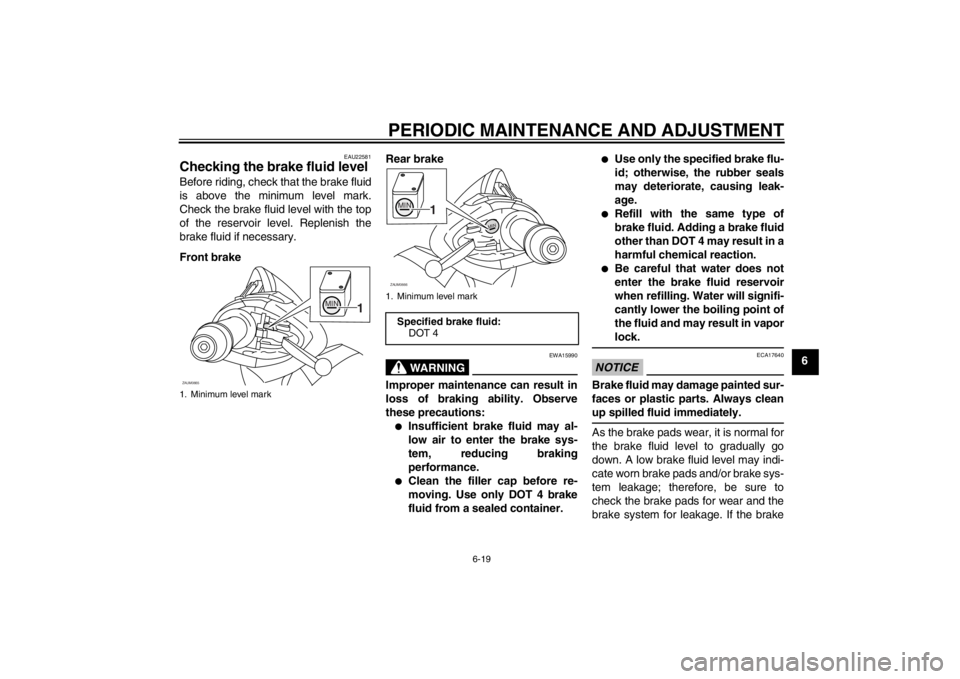brake pads YAMAHA XCITY 250 2013 Owners Manual
[x] Cancel search | Manufacturer: YAMAHA, Model Year: 2013, Model line: XCITY 250, Model: YAMAHA XCITY 250 2013Pages: 82, PDF Size: 1.89 MB
Page 6 of 82

TABLE OF CONTENTSSAFETY INFORMATION ..................1-1
Further safe-riding points ................1-5
DESCRIPTION ..................................2-1
Left view ..........................................2-1
Right view ........................................2-2
Controls and instruments.................2-3
INSTRUMENT AND CONTROL
FUNCTIONS.......................................3-1
Main switch/steering lock ................3-1
Indicator lights and warning light ....3-1
Speedometer ..................................3-2
Fuel gauge ......................................3-2
Coolant temperature gauge ............3-3
Multi-function display ......................3-3
Handlebar switches ........................3-6
Front brake lever ............................3-7
Rear brake lever .............................3-7
Fuel tank cap ..................................3-7
Fuel .................................................3-8
Catalytic converters ........................3-9
Seat ..............................................3-10
Storage compartments .................3-11
Windshield ....................................3-12
Adjusting the shock absorber
assemblies ................................3-13
Carrier (if equipped).......................3-13
Luggage hook ...............................3-14
Sidestand ......................................3-14
Ignition circuit cut-off system ........3-15FOR YOUR SAFETY –
PRE-OPERATION CHECKS............. 4-1
OPERATION AND IMPORTANT
RIDING POINTS................................. 5-1
Starting the engine ......................... 5-1
Starting off ...................................... 5-2
Acceleration and deceleration ........ 5-2
Braking ........................................... 5-3
Tips for reducing fuel
consumption ............................... 5-3
Engine break-in .............................. 5-4
Parking ........................................... 5-4
PERIODIC MAINTENANCE AND
ADJUSTMENT................................... 6-1
Owner’s tool kit ............................... 6-2
Periodic maintenance chart for the
emission control system ............. 6-3
General maintenance and
lubrication chart .......................... 6-4
Removing and installing cowlings
and panels .................................. 6-7
Checking the spark plug ................. 6-8
Engine oil ....................................... 6-9
Final transmission oil .................... 6-11
Coolant ......................................... 6-12
Air filter and V-belt case air filter
elements ................................... 6-13
Checking the throttle grip free
play ........................................... 6-14Valve clearance ........................... 6-15
Tires ............................................. 6-15
Cast wheels ................................. 6-17
Front and rear brake lever free
play ........................................... 6-17
Checking the front and rear brake
pads .......................................... 6-18
Checking the brake fluid level ...... 6-19
Changing the brake fluid .............. 6-20
Checking and lubricating the
cables ....................................... 6-20
Checking and lubricating the
throttle grip and cable ............... 6-21
Lubricating the front and rear
brake levers .............................. 6-21
Checking and lubricating the
centerstand and sidestand ....... 6-21
Checking the front fork ................. 6-22
Checking the steering .................. 6-23
Checking the wheel bearings ....... 6-23
Battery ......................................... 6-23
Replacing the fuses ..................... 6-25
Replacing a headlight bulb .......... 6-26
Replacing a front turn signal light
bulb ........................................... 6-27
Replacing a tail/brake light bulb or
a rear turn signal light bulb ....... 6-28
Replacing the license plate light
bulb ........................................... 6-29
Replacing an auxiliary light
bulb ........................................... 6-29U5B2E4E0.book Page 1 Friday, June 1, 2012 9:06 AM
Page 12 of 82

SAFETY INFORMATION
1-5
1Aftermarket Tires and Rims
The tires and rims that came with your
scooter were designed to match the
performance capabilities and to provide
the best combination of handling, brak-
ing, and comfort. Other tires, rims, siz-
es, and combinations may not be
appropriate. Refer to page 6-15 for tire
specifications and more information on
replacing your tires.
Transporting the Scooter
Be sure to observe following instruc-
tions before transporting the scooter in
another vehicle.
●
Remove all loose items from the
scooter.
●
Point the front wheel straight
ahead on the trailer or in the truck
bed, and choke it in a rail to pre-
vent movement.
●
Secure the scooter with tie-downs
or suitable straps that are attached
to solid parts of the scooter, such
as the frame or upper front fork tri-
ple clamp (and not, for example, to
rubber-mounted handlebars or
turn signals, or parts that could
break). Choose the location for thestraps carefully so the straps will
not rub against painted surfaces
during transport.
●
The suspension should be com-
pressed somewhat by the tie-
downs, if possible, so that the
scooter will not bounce excessive-
ly during transport.
EAU10373
Further safe-riding points ●
Be sure to signal clearly when
making turns.
●
Braking can be extremely difficult
on a wet road. Avoid hard braking,
because the scooter could slide.
Apply the brakes slowly when
stopping on a wet surface.
●
Slow down as you approach a cor-
ner or turn. Once you have com-
pleted a turn, accelerate slowly.
●
Be careful when passing parked
cars. A driver might not see you
and open a door in your path.
●
Railroad crossings, streetcar rails,
iron plates on road construction
sites, and manhole covers be-
come extremely slippery when
wet. Slow down and cross them
with caution. Keep the scooter up-
right, otherwise it could slide out
from under you.
●
The brake pads could get wet
when you wash the scooter. After
washing the scooter, check the
brakes before riding.
U5B2E4E0.book Page 5 Friday, June 1, 2012 9:06 AM
Page 14 of 82

DESCRIPTION
2-1
2
EAU10410
Left view
1
2 3 4 5 76 8
1. Rear storage compartment (page 3-11)
2. Shock absorber assembly spring preload adjusting ring (page 3-13)
3. Final transmission oil filler cap (page 6-11)
4. Air filter element (page 6-13)
5. V-belt case air filter element (page 6-13)
6. Sidestand (page 3-14)
7. Coolant level check window (page 6-12)
8. Front brake pads (page 6-18)U5B2E4E0.book Page 1 Friday, June 1, 2012 9:06 AM
Page 15 of 82

DESCRIPTION
2-2
2
EAU10420
Right view
2 13 4
5 6 7 8
1. Grab bar (page 5-2)
2. Main fuse/fuse box (page 6-25)
3. Battery (page 6-23)
4. Coolant reservoir cap (page 6-12)
5. Fuel tank cap (page 3-7)
6. Engine oil filler cap (page 6-9)
7. Centerstand (page 6-21)
8. Rear brake pads (page 6-18)
U5B2E4E0.book Page 2 Friday, June 1, 2012 9:06 AM
Page 33 of 82

FOR YOUR SAFETY – PRE-OPERATION CHECKS
4-1
4
EAU15596
Inspect your vehicle each time you use it to make sure the vehicle is in safe operating condition. Always follow the inspection
and maintenance procedures and schedules described in the Owner’s Manual.
WARNING
EWA11151
Failure to inspect or maintain the vehicle properly increases the possibility of an accident or equipment damage.
Do not operate the vehicle if you find any problem. If a problem cannot be corrected by the procedures provided in
this manual, have the vehicle inspected by a Yamaha dealer.Before using this vehicle, check the following points:
ITEM CHECKS PAGE
Fuel Check fuel level in fuel tank.
Refuel if necessary.
Check fuel line for leakage.3-8
Engine oil Check oil level in engine.
If necessary, add recommended oil to specified level.
Check vehicle for oil leakage.6-9
Final transmission oil Check vehicle for oil leakage. 6-11
Coolant Check coolant level in reservoir.
If necessary, add recommended coolant to specified level.
Check cooling system for leakage.6-12
Front brake Check operation.
If soft or spongy, have Yamaha dealer bleed hydraulic system.
Check brake pads for wear.
Replace if necessary.
Check fluid level in reservoir.
If necessary, add specified brake fluid to specified level.
Check hydraulic system for leakage.6-17, 6-18, 6-19
U5B2E4E0.book Page 1 Friday, June 1, 2012 9:06 AM
Page 34 of 82

FOR YOUR SAFETY – PRE-OPERATION CHECKS
4-2
4
Rear brake Check operation.
If soft or spongy, have Yamaha dealer bleed hydraulic system.
Check brake pads for wear.
Replace if necessary.
Check fluid level in reservoir.
If necessary, add specified brake fluid to specified level.
Check hydraulic system for leakage.6-17, 6-18, 6-19
Throttle grip Make sure that operation is smooth.
Check throttle grip free play.
If necessary, have Yamaha dealer adjust throttle grip free play and lubricate cable
and grip housing.6-14, 6-21
Wheels and tires Check for damage.
Check tire condition and tread depth.
Check air pressure.
Correct if necessary.6-15, 6-17
Brake levers Make sure that operation is smooth.
Lubricate lever pivoting points if necessary.6-21
Centerstand, sidestand Make sure that operation is smooth.
Lubricate pivots if necessary.6-21
Chassis fasteners Make sure that all nuts, bolts and screws are properly tightened.
Tighten if necessary.—
Instruments, lights, signals
and switches Check operation.
Correct if necessary.—
Sidestand switch Check operation of ignition circuit cut-off system.
If system is not working correctly, have Yamaha dealer check vehicle.3-14 ITEM CHECKS PAGE
U5B2E4E0.book Page 2 Friday, June 1, 2012 9:06 AM
Page 42 of 82

PERIODIC MAINTENANCE AND ADJUSTMENT
6-4
6
EAU1770E
General maintenance and lubrication chart NO. ITEM CHECK OR MAINTENANCE JOBODOMETER READING
ANNUAL
CHECK 1000 km
(600 mi)10000 km
(6000 mi)20000 km
(12000 mi)30000 km
(18000 mi)40000 km
(24000 mi)
1 Air filter element Replace.√√
2V-belt case air filter
element Clean.√√√√
3*Front brake Check operation, fluid level and
vehicle for fluid leakage.√√√√√√
Replace brake pads. Whenever worn to the limit
4*Rear brake Check operation, fluid level and
vehicle for fluid leakage.√√√√√√
Replace brake pads. Whenever worn to the limit
5*Brake hoses Check for cracks or damage.
Check for correct routing and
clamping.√√√√√
Replace. Every 4 years
6*Wheels Check runout and for damage.√√√√
7*Tires Check tread depth and for dam-
age.
Replace if necessary.
Check air pressure.
Correct if necessary.√√√√√
8*Wheel bearings Check bearing for looseness or
damage.√√√√
U5B2E4E0.book Page 4 Friday, June 1, 2012 9:06 AM
Page 56 of 82

PERIODIC MAINTENANCE AND ADJUSTMENT
6-18
6
WARNING
EWA14211
A soft or spongy feeling in the brake
lever can indicate the presence of air
in the hydraulic system. If there is air
in the hydraulic system, have a
Yamaha dealer bleed the system be-
fore operating the vehicle. Air in the
hydraulic system will diminish the
braking performance, which may re-
sult in loss of control and an acci-
dent.
EAU22392
Checking the front and rear
brake pads The front and rear brake pads must be
checked for wear at the intervals spec-
ified in the periodic maintenance and
lubrication chart.
EAU22420
Front brake pads
Each front brake pad is provided with a
wear indicator groove, which allows
you to check the brake pad wear with-
out having to disassemble the brake.
To check the brake pad wear, check
the wear indicator groove. If a brake
pad has worn to the point that the wearindicator groove has almost disap-
peared, have a Yamaha dealer replace
the brake pads as a set.
EAU22500
Rear brake pads
Check each rear brake pad for damage
and measure the lining thickness. If a
brake pad is damaged or if the lining
thickness is less than 0.8 mm (0.03 in),
have a Yamaha dealer replace the
brake pads as a set.
1. Brake pad wear indicator grooveZAUM0663
1
1
1. Lining thicknessZAUM0664
1
U5B2E4E0.book Page 18 Friday, June 1, 2012 9:06 AM
Page 57 of 82

PERIODIC MAINTENANCE AND ADJUSTMENT
6-19
6
EAU22581
Checking the brake fluid level Before riding, check that the brake fluid
is above the minimum level mark.
Check the brake fluid level with the top
of the reservoir level. Replenish the
brake fluid if necessary.
Front brakeRear brake
WARNING
EWA15990
Improper maintenance can result in
loss of braking ability. Observe
these precautions:●
Insufficient brake fluid may al-
low air to enter the brake sys-
tem, reducing braking
performance.
●
Clean the filler cap before re-
moving. Use only DOT 4 brake
fluid from a sealed container.
●
Use only the specified brake flu-
id; otherwise, the rubber seals
may deteriorate, causing leak-
age.
●
Refill with the same type of
brake fluid. Adding a brake fluid
other than DOT 4 may result in a
harmful chemical reaction.
●
Be careful that water does not
enter the brake fluid reservoir
when refilling. Water will signifi-
cantly lower the boiling point of
the fluid and may result in vapor
lock.
NOTICE
ECA17640
Brake fluid may damage painted sur-
faces or plastic parts. Always clean
up spilled fluid immediately.As the brake pads wear, it is normal for
the brake fluid level to gradually go
down. A low brake fluid level may indi-
cate worn brake pads and/or brake sys-
tem leakage; therefore, be sure to
check the brake pads for wear and the
brake system for leakage. If the brake
1. Minimum level markZAUM0665
MIN
1
1. Minimum level mark
Specified brake fluid:
DOT 4ZAUM0666MIN
1
MIN
U5B2E4E0.book Page 19 Friday, June 1, 2012 9:06 AM
Page 79 of 82

INDEX
AAcceleration and deceleration ................ 5-2
Air filter and V-belt case air filter
elements ............................................. 6-13
Auxiliary light bulb, replacing ................ 6-29BBattery .................................................. 6-23
Brake fluid, changing ............................ 6-20
Brake fluid level, checking .................... 6-19
Brake lever, front .................................... 3-7
Brake lever, rear ..................................... 3-7
Brake levers, lubricating ....................... 6-21
Braking ................................................... 5-3CCables, checking and lubricating .......... 6-20
Care ........................................................ 7-1
Carrier (if equipped).............................. 3-13
Catalytic converters ................................ 3-9
Centerstand and sidestand, checking
and lubricating .................................... 6-21
Coolant ................................................. 6-12
Coolant temperature gauge .................... 3-3
Cowlings and panels, removing and
installing ............................................... 6-7DDimmer switch ........................................ 3-6
Display, multi-function ............................ 3-3EEngine break-in ...................................... 5-4
Engine oil ................................................ 6-9
Engine trouble warning light ................... 3-2FFinal transmission oil ............................ 6-11
Front and rear brake lever free play ..... 6-17Front and rear brake pads, checking .... 6-18
Front fork, checking...............................6-22
Fuel ......................................................... 3-8
Fuel consumption, tips for reducing ........ 5-3
Fuel gauge .............................................. 3-2
Fuel tank cap........................................... 3-7
Fuses, replacing .................................... 6-25
HHandlebar switches ................................. 3-6
Headlight bulb, replacing....................... 6-26
High beam indicator light......................... 3-1
Horn switch ............................................. 3-6IIdentification numbers ............................. 9-1
Ignition circuit cut-off system ................. 3-15
Indicator lights and warning light ............. 3-1LLicense plate light bulb, replacing ......... 6-29
Luggage hook ....................................... 3-14MMain switch/steering lock ........................ 3-1
Maintenance and lubrication, periodic..... 6-4
Maintenance, emission control system ... 6-3
Model label .............................................. 9-1PParking ....................................................5-4
Part locations .......................................... 2-1SSafe-riding points .................................... 1-5
Safety information ...................................1-1
Seat ....................................................... 3-10
Shock absorber assemblies,
adjusting.............................................. 3-13
Sidestand .............................................. 3-14Spark plug, checking .............................. 6-8
Specifications.......................................... 8-1
Speedometer .......................................... 3-2
Starting off .............................................. 5-2
Starting the engine.................................. 5-1
Start switch ............................................. 3-6
Steering, checking ................................ 6-23
Storage ................................................... 7-3
Storage compartments ......................... 3-11
TTail/brake light bulb or rear turn signal
light bulb, replacing............................. 6-28
Throttle grip and cable, checking and
lubricating ........................................... 6-21
Throttle grip free play, checking............ 6-14
Tires ...................................................... 6-15
Tool kit .................................................... 6-2
Troubleshooting .................................... 6-29
Troubleshooting charts ......................... 6-31
Turn signal indicator light ........................ 3-1
Turn signal light bulb (front),
replacing ............................................. 6-27
Turn signal switch ................................... 3-6VValve clearance .................................... 6-15
Vehicle identification number .................. 9-1WWheel bearings, checking..................... 6-23
Wheels .................................................. 6-17
Windshield ............................................ 3-12
U5B2E4E0.book Page 1 Friday, June 1, 2012 9:06 AM